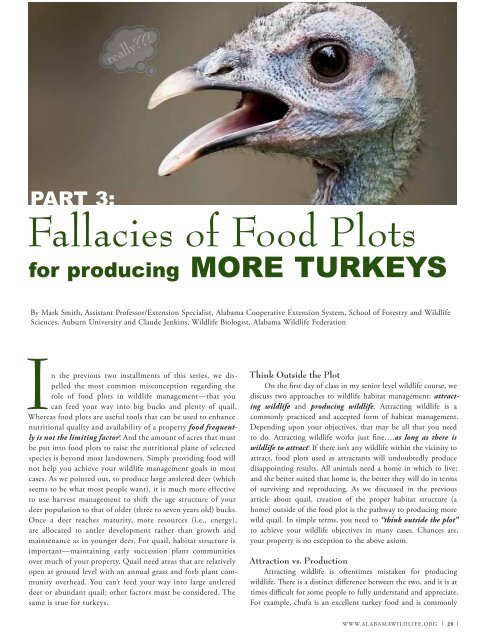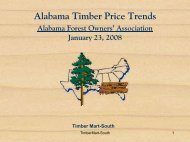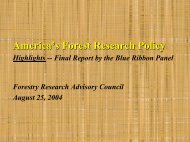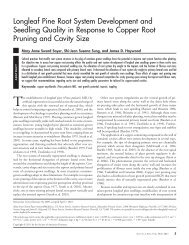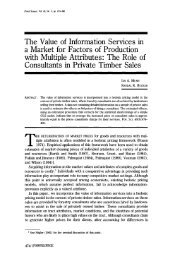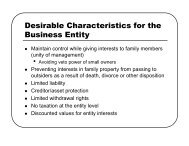Part 3: Fallacies of Food Plots for producing More Turkeys
Part 3: Fallacies of Food Plots for producing More Turkeys
Part 3: Fallacies of Food Plots for producing More Turkeys
Create successful ePaper yourself
Turn your PDF publications into a flip-book with our unique Google optimized e-Paper software.
PART 3:<br />
<strong>Fallacies</strong> <strong>of</strong> <strong>Food</strong> <strong>Plots</strong><br />
<strong>for</strong> <strong>producing</strong> MORE TURKEYS<br />
By Mark Smith, Assistant Pr<strong>of</strong>essor/Extension Specialist, Alabama Cooperative Extension System, School <strong>of</strong> Forestry and Wildlife<br />
Sciences, Auburn University and Claude Jenkins, Wildlife Biologist, Alabama Wildlife Federation<br />
In the previous two installments <strong>of</strong> this series, we dispelled<br />
the most common misconception regarding the<br />
role <strong>of</strong> food plots in wildlife management—that you<br />
can feed your way into big bucks and plenty <strong>of</strong> quail.<br />
Whereas food plots are useful tools that can be used to enhance<br />
nutritional quality and availability <strong>of</strong> a property food frequently<br />
is not the limiting factor! And the amount <strong>of</strong> acres that must<br />
be put into food plots to raise the nutritional plane <strong>of</strong> selected<br />
species is beyond most landowners. Simply providing food will<br />
not help you achieve your wildlife management goals in most<br />
cases. As we pointed out, to produce large antlered deer (which<br />
seems to be what most people want), it is much more effective<br />
to use harvest management to shift the age structure <strong>of</strong> your<br />
deer population to that <strong>of</strong> older (three to seven years old) bucks.<br />
Once a deer reaches maturity, more resources (i.e., energy),<br />
are allocated to antler development rather than growth and<br />
maintenance as in younger deer. For quail, habitat structure is<br />
important—maintaining early succession plant communities<br />
over much <strong>of</strong> your property. Quail need areas that are relatively<br />
open at ground level with an annual grass and <strong>for</strong>b plant community<br />
overhead. You can’t feed your way into large antlered<br />
deer or abundant quail; other factors must be considered. The<br />
same is true <strong>for</strong> turkeys.<br />
Think Outside the Plot<br />
On the first day <strong>of</strong> class in my senior level wildlife course, we<br />
discuss two approaches to wildlife habitat management: attract-t<br />
ing wildlife and <strong>producing</strong> wildlife. Attracting wildlife is a<br />
commonly practiced and accepted <strong>for</strong>m <strong>of</strong> habitat management.<br />
Depending upon your objectives, that may be all that you need<br />
to do. Attracting wildlife works just fine….as long as there is<br />
wildlife to attract! t If there isn’t any wildlife within the vicinity to<br />
attract, food plots used as attractants will undoubtedly produce<br />
disappointing results. All animals need a home in which to live;<br />
and the better suited that home is, the better they will do in terms<br />
<strong>of</strong> surviving and re<strong>producing</strong>. As we discussed in the previous<br />
article about quail, creation <strong>of</strong> the proper habitat structure (a<br />
home) outside <strong>of</strong> the food plot is the pathway to <strong>producing</strong> more<br />
wild quail. In simple terms, you need to “think outside the plot”<br />
to achieve your wildlife objectives in many cases. Chances are,<br />
your property is no exception to the above axiom.<br />
Attraction vs. Production<br />
Attracting wildlife is <strong>of</strong>tentimes mistaken <strong>for</strong> <strong>producing</strong><br />
wildlife. There is a distinct difference between the two, and it is at<br />
times difficult <strong>for</strong> some people to fully understand and appreciate.<br />
For example, chufa is an excellent turkey food and is commonly<br />
WWW.ALABAMAWILDLIFE.ORG 29
"<br />
<strong>Food</strong> plots are supplemental practices—practices that should<br />
1"<br />
be used in addition to existing habitat and population management practices.<br />
planted as a winter/spring food source. <strong>Turkeys</strong> congregate to areas<br />
where chufa is planted to take advantage <strong>of</strong> this nutritious and<br />
relatively easy-to-obtain food source. Obviously, these birds are<br />
coming from somewhere, either from other areas <strong>of</strong> your property<br />
or from adjacent properties. These birds are being producedd else-<br />
where. Intuitively, one would think that they’ve produced more<br />
turkeys because they consistently see birds on a chufa field during<br />
the hunting season. But this is in all likelihood not necessarily<br />
so. You’ve likely just attracted turkeys to the area, giving you the<br />
impression that you’ve produced turkeys. But have you really produced<br />
more turkeys Probably not. Sure, the chufa plot has con-<br />
tributed to some extent to the nutritional needs <strong>of</strong> turkeys, and<br />
improved body condition can lead to increased nesting ef<strong>for</strong>t. But<br />
has it really contributed to the production <strong>of</strong> turkey, particularly<br />
survival and reproduction Or more specifically, did this chufa<br />
plot measurably enhance the two main drivers <strong>of</strong> turkey popula-<br />
tions: nest success and poult survival Likely not. Similar to quail,<br />
turkeys need proper habitat outside <strong>of</strong> the food plot to survive<br />
and successfully reproduce. As pr<strong>of</strong>essional wildlife biologists, we<br />
spend our time on managing habitat to produce more turkeys, not<br />
just attracting them.<br />
Addressing the Survival Bottleneck<br />
Adult turkeys generally have high survival rates. In fact, by<br />
far the number one cause <strong>of</strong> death <strong>of</strong> mature toms is hunters.<br />
Starvation <strong>of</strong> adult turkeys is an extremely rare occurrence, especially<br />
in the Southeast. So, to produce turkeys, you need to concentrate<br />
on enhancing habitat to improve the survival “bottleneck” – nest<br />
success and poult survival. Nest success in turkeys is highly variable,<br />
ranging from 30 to 65 percent on average, but may be as low<br />
as 15 percent in some areas. Poult survival is generally low, with as<br />
many as 80 percent <strong>of</strong> poults dying be<strong>for</strong>e they reach 14 days <strong>of</strong><br />
age. Being two weeks old is important because that’s when poults<br />
become capable <strong>of</strong> flight and can then roost <strong>of</strong>f the ground. Having<br />
proper nesting and brood rearing habitat will help increase both<br />
nest success and poult survival. In fact, quality nesting habitat, and<br />
especially brood habitat, are usually limiting on most properties.<br />
Turkey poults are very similar to quail chicks in their habitat needs<br />
and food requirements. <strong>Food</strong>s, such as grain crops, have limited<br />
value because during the first few months, turkey poults eat insects<br />
to gain protein needed to grow feathers and put on body mass. So<br />
during this time, we look mainly at managing habitat to produce<br />
abundant insect populations that are easily accessible to poults.<br />
Habitat Is Home<br />
Managing outside <strong>of</strong> food plots is important <strong>for</strong> turkeys.<br />
Although extremely adaptable to a wide range <strong>of</strong> habitat conditions,<br />
turkeys do prefer open areas, perhaps about 10 to 25 percent<br />
<strong>of</strong> a property in well-dispersed openings which provide grasses,<br />
<strong>for</strong>bs, and subsequently insects. Nesting habitat can be highly variable<br />
<strong>for</strong> turkeys. However, some portion <strong>of</strong> the property should<br />
consist <strong>of</strong> herbaceous cover with some woody brush (shrubs).<br />
Recent cutovers and young plantations <strong>of</strong>fer good nesting cover.<br />
Nesting hens need to be concealed from above and from the sides.<br />
Brood-rearing habitat includes grassy-weedy areas such as openings,<br />
right-<strong>of</strong>-ways, lightly-grazed pastures, and open (thinned)<br />
pine stands which are prescribed-burned on a frequent (two to five<br />
year) rotation. Oftentimes, roadsides can be managed <strong>for</strong> quality<br />
brood habitat by daylighting roads and then mowing or discing<br />
(preferred) roadsides periodically. With average yearly home range<br />
size between 1,000 to 3,000 acres, what your neighbor is doing on<br />
his/her property is important. In other words, what your neighbor<br />
TES RANDLE JOLLY<br />
30<br />
ALABAMA WILDLIFE SPRING 2009


